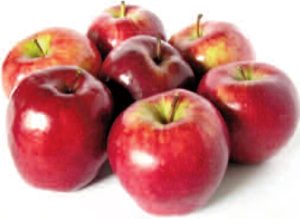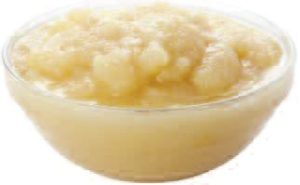GARDEN WORKS: ‘Tis the season for applesauce
As the cool nights awaken to crisp, breezy days, the smell of cooking applesauce fills the kitchen. That’s what this article is about, making applesauce! Many thanks to Roberta Bailey for teaching me how a while ago. I’ll share with you all a few hints if you’d like:
 There’s no fancy recipe or anything. Simply use apples that are good enough on their own. I forgo adding sugar or spices, as I’m interested in the unique flavors of the fruits — especially if these flavors are particularly suit-able for sauce. (The sauce can always be doctored up later if need be.)
There’s no fancy recipe or anything. Simply use apples that are good enough on their own. I forgo adding sugar or spices, as I’m interested in the unique flavors of the fruits — especially if these flavors are particularly suit-able for sauce. (The sauce can always be doctored up later if need be.)
When I have a large quantity of apples, I tend to be particular and choose the ones that are ripe and in good shape; these are the ones that make superior sauce.
Of course, some varieties are better than others for sauce. An old tree in my backyard makes the best single-variety for canned applesauce I’ve ever tried. No one seems to know it’s name, and I call it “Dutton Gold.” While any old apple presumably could be used- the ones that cook up creamy, with the right balance of sweetness and tartness, and a hint of spice – are guaranteed to please. If you have access to the varieties Black Oxford, Cortland, Gravenstein, Northern Spy, Roxbury Russet, Sweet 16, Tolman Sweet, Wealthy or Wolf River, then by all means, make good use of them!
 Drops are fine for sauce as long as they are washed well and used up quickly – preferably the day they are gathered. Some trees have the habit of dropping apples as they ripen, others drop because they are bad. I won’t pass up a good apple because of a bruise or wormhole, but I’ll make sure to inspect carefully and trim out any bad spots, staying clear of apple mold.
Drops are fine for sauce as long as they are washed well and used up quickly – preferably the day they are gathered. Some trees have the habit of dropping apples as they ripen, others drop because they are bad. I won’t pass up a good apple because of a bruise or wormhole, but I’ll make sure to inspect carefully and trim out any bad spots, staying clear of apple mold.
The advantages of tree-picked fruits are that they’re usually better than drops cosmetically and have a much wider window of storage and processing opportunities. If you’d like to make applesauce right away, then use tree-ripened (as opposed to storage) apples. Storage varieties improve their flavor while in storage, so if you prefer, you can make good apple-sauce from these in the off sea-son. Also, instead of going through the time and energy-intensive activities of canning a large amount of sauce, you could just take out a small amount of stored apples and cook up enough applesauce for a meal or two.
Depending on what’s on hand, I’ll make either a single variety or mixed sauce. I simply scrub and rinse the apples, slice them off the cores, and place them into a saucepan. To really jazz it up you can add elderberries, aronia, or other brightly-colored berries for visual appeal. I pour in just a sufficient amount of filtered water to keep them from scorching, then cook on medium until tender enough to run through a food mill or Foley. Usually I will run the pulp through a few times to really wring it out. Then I’ll heat it up again if needed and into the jars and water bath it goes for 20 minutes. That’s it!
Responsible journalism is hard work!
It is also expensive!
If you enjoy reading The Town Line and the good news we bring you each week, would you consider a donation to help us continue the work we’re doing?
The Town Line is a 501(c)(3) nonprofit private foundation, and all donations are tax deductible under the Internal Revenue Service code.
To help, please visit our online donation page or mail a check payable to The Town Line, PO Box 89, South China, ME 04358. Your contribution is appreciated!


Leave a Reply
Want to join the discussion?Feel free to contribute!